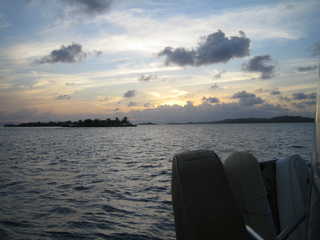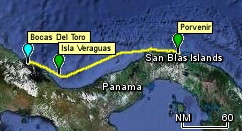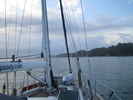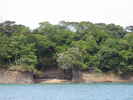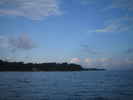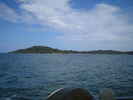A bumpy, lumpy, difficult overnight from Porvenir to Isla Veraguas and Bocas Del ToroOn Saturday, December 13th, we got up at 4:30 a.m. had our coffee and were ready to pull up anchor and depart Porvenir by 5:00 am. Our plan is to do the entire leg from the San Blas to Bocas Del Toro in one go, just about 220 nm. We expect it to take us about 36 hours if we can maintain an average of 6 knots. This will be our first 24 hr passage in almost 8 months, since we went from Puesta Del Sol, Nicaragua, to Bahia Saint Elena, Costa Rica way back on April 23rd, 2008. After pulling up anchor, we motor out of the Porvenir Channel and around some reefs to get out into the ocean before we head slightly north of west to a point somewhere off of Isla Linton where we will make a slight turn to due west to get to Bocas Del Toro. The full moon is shining bright ahead of us in the west at 5:00 a.m., and it's followed shortly by the sun rising behind us at 6:00 am or so. There's a pretty nice breeze, about 15 knots from the northwest, so we put up the sails and turn off the motor and are soon making 5-6 knots under sail alone. Even though this is a little less than our desired average, it's still pretty nice to sail, so we try to keep it up as long as possible. As we're crossing the Escribanos Shoals, where we had caught 3 Wahoo on the way out to the San Blas, we put both fishing poles into action in hopes of catching another couple of these beauties on the return trip, but it is to no avail as nothing bites. However, around 10:00 a.m., well after the shoals, there's a hit, but when I reel it in, not only are my two lines tangled together, but rather than a wahoo, I have a small 3' shark on the line. Not really familiar with them and their edibility, we decide to cut him loose, which we do, and after attempting to untangle the fishing lines, and finally giving up and cutting them, we decide to put the fishing poles away. There will be plenty of work on the passage without adding the messy and onerous task of cleaning fish. By noon, the wind has died down and we are no longer able to sail, so we reluctantly start the motor and try to increase our speed to make up our average, but there seems to be a counter current working against us, and we can do no better than 5.5 knots. The seas, at 3-5 feet, are also right on our nose, and it becomes a little bouncy as we pass several boats from Linton making their way east to the San Blas Islands. By 3:00 pm, we have made it past Linton and are now looking at the big Golfito de Mosquitos (Gulf of Mosquitos) that we have to cross to get to Bocas Del Toro. As we round the point, and set the rhumb line for BDT, off to our right we can see several large ships inward bound for the Panama Canal and know that we'll soon be crossing a very busy shipping lane. Thus, we are somewhat dismayed when the ships don't show up on our AIS (automatic identification system) like they're supposed to. The AIS is supposed to tell us how far away the ships are, what their course is, and give us a sense of security and safety when traversing waters plied by these big fast moving ships, but it doesn't seem to be working. I go below several times and diddle with the system, testing it, hooking it up to an alternative power supply, and finally taking it apart and looking inside at the printed circuit boards before finally declaring it dead. That's too bad, because it was for these conditions that I purchased the unit, and for it to die now is about the worst possible time. Without the AIS, we're forced to use the radar and our eyeballs to determine which way these ships are moving. Several times we have to alter course and speed up or slow down so as to stay safely away from them, because it's always unnerving to see a 300,000 ton boat making 20 knots two-to-three miles away from you. By 6:00 pm, we have made it through the worst of the ship traffic, and as we are crossing the gulf, we are moving steadily farther and farther from land, to about 25 miles offshore. The seas continue to build, now they're 4-6 feet, and they bang into us. Also the wind has now come up to 15 knots or so, and wouldn't you know it, it's out of the west, directly on our nose, so our progress slows to a dismal 4-5 knots. It's all we can do to heat up some soup for dinner as the boat is banging around, making the ride very bumpy. At 5 knots we won't make BDT until well after dark the following day, so by 7:00 pm, when the sun has set and it is cloudy and starting to rain, we decide to alter our plan and course to more inshore, to stop at an island called Isla Veraguas, about 40 nm short of BDT. We decide on our watch shifts - I will take 2:00 am to 6:00 am watch - but already we know that neither of us will rest very well with the banging and bouncing of the boat. There is no way to stay on the bed in the forward master cabin, so we take turns scrunching ourselves up against the wall in the port aft cabin trying to sleep a little. During the long, bouncy, rainy night, we get to see a little of the full moon as it occasionally breaks through the clouds on our respective watches, but the winds pick up to the 20-25 knot range and the waves look ominous in the moonlight as they confront RHAPSODY every inch of the way, building to perhaps 5-7 feet, but at 3 second intervals, which is very close together, resulting in a very rough ride. By 6:00 am, when the sun rises, we are only making 3.6 knots, even though we also have put up the mainsail and veered off course a bit so that it will fill. RHAPSODY is constantly crashing into the waves, sending up huge spumes of spray over the deck to the dodger windshield. It seems to take forever to get through the next 5 or so hours, until finally, around 2:00 p.m. we are headed into the anchorage at Isla Veraguas. Instead of the 220 nm we had hoped to make, we have only gone 170 nm or so by now. But the passage is not over yet! Finally granted a little break from the rain, we pull into the anchorage designated in the Bauhaus book, near the west end of the island, but due to the fact that the swells seem to be coming from two directions, both from the NorthWest AND the NorthEast, we find that the anchorage is untenable. There are 2-3' waves breaking less than 100' from where the book says we should anchor! So, on our own now, we slowly scope out the southeast side of the island using the FLS (Forward Looking Sonar) and depth sounder, avoiding a big reef in the middle of the island, until we finally settle, at about 3:00 pm, on a spot located at 9° 5.294N; 81° 33.066W. Though there is still about a 1' chop, we are both very tired, and agree that it would be better to drop the hook here and get some sleep than to risk trying to go to the next available anchorage, about 15 nm away, at dark. It works out ok, as once we put the hook down in about 12' of water (with about 120' of chain for a super cautious 10:1 scope), the boat is safe and secure. And even if it's moving a little, it's way better than trying to sleep the previous night in 4-6' seas, so, soon after we anchor, we celebrate our survival with a shot and a beer. As ship's engineer, I have one task remaining, before we go to BDT, and that is to empty the holding tanks for the heads. Wouldn't you know it, that, bone tired as I am, as I turn on the macerator for the port cabin, it grinds to a halt, plugged up. So I spend about an hour disassembling and rebuilding the macerator. Then when I go to empty the starboard cabin, it too fails. Boy was I pissed as I then spent another hour rebuilding the other macerator as well. By 8:00 or so, I finally got to do my "computer stuff", like update the logbook, send out an arrival email, and, believe it or not, pay our bills using the SSB and email, before I finally got to take a shower and get to sleep around 9:30 pm that night. The next day, we made a pretty uneventful 42nm passage from Isla Veraguas to Bocas Del Toro, getting under way at 5:00 am again. The seas and wind were still pretty much on our nose, but it wasn't as rainy, and most importantly, it wasn't a night passage, so the 10 hours or so were not as difficult. We kept the mainsail up for stability and an occasional boost to our speed. Along the way we used the Satphone to call the Bocas Marina and get a slip, and when we put the sail away and entered the buoyed main channel at 2:00 pm or so, Dana, the dockmaster, guided us in on VHF channel 68, telling us where to turn to avoid reefs, and how to get into the narrower bight channel into the marina. We finally entered the slip, around 3:00 pm. It was a little hairy getting in, as the individual slips are only 5 ft long fingers with cement posts set at the entrances. With some help, at 4:00 RHAPSODY was secure and we had been to the marina office to check in. Then it was over to the marina's charming Calypso Cantina where we had the first of several rounds of drinks before a wonderful taco dinner. Welcome to Bocas Del Toro! |
